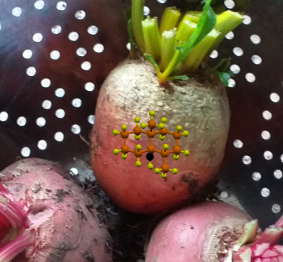
When I was young, a couple of times each year my family would head out on a Sunday afternoon to visit my Auntie Nancy, who would reward us with a big tea. Tinned salmon, crisps, and trifle: typical 1970s fare. And beetroot, which I hated: thick purple slabs steeped in vinegar, which tasted of soil.
1) Let’s start with that earthy taste, which is due to a chemical called geosmin (Figure 1). This is present in really small amounts in beetroot, in the order of 10 to 30 parts per billion (J. Agric. Food Chem., 2003, 51, 1021-1025), but it turns out that the human body is really sensitive to it and can detect it in water at levels down to 1 parts per trillion (Chemical Senses, 1992, 17, 23-26). Geosmin is the chemical responsible for the characteristic smell of rain on a dry surface, which is called petrichor, and it also causes fish farmed in freshwater to taste different from those farmed in seawater.
2) Next, the colour. The main pigment in red beetroot is called betanin, and its structure is shown in Figure 2. There’s quite a lot going on there, so I’ve colour-coded it to help make sense of it.
Betanin is a glycoside, which is a chemical that is formed by joining a sugar to something else. In this case the sugar is glucose, and this is the bit highlighted in red. The bit responsible for absorbing light and making the colour is called a chromophore, and that’s the bit in blue. There are three double bonds arranged like a staircase (conjugated is the scientific term), and molecules where that kind of arrangement is present tend to be coloured. Betanin is also a zwitterion, which is a molecule that has both positive and negative charges.
Its intense colour has led to betanin being used as a food colorant (it’s E162). Because it’s not very stable to heat, it tends to be used in cold things like strawberry milkshakes (Figure 3) and ice creams. It also changes colour according to pH. In acidic media (like Auntie Nancy’s vinegar) it’s dark purple-red, but at higher pH it becomes more blue-violet. This has recently been proposed as a mechanism to indicate when sutures become infected. Human skin is naturally slightly acidic, but becomes alkaline when infected. So, dyeing the suture thread with betanin creates a thread that is purple when everything is OK, but changes colour when infected. This idea was recently proposed by an American high-school student in a science competition.
Nowadays, not all beet are purple. Some are golden, and a chemical named Vulgaxanthin I is responsible for that (Figure 4). This pigment is also present in purple beetroot, but is masked by the more strongly coloured purple colour.

3) Closely related to beetroot is sugar beet, which is responsible for about 20% of world sugar production (the rest comes from sugar cane) (UN Food and Agriculture Organisation, 2009). Sugar beet is about 75% water, 20% sugar and 5% pulp, and has been selectively bred from mangelwurzel over the past 200 years.
The extraction of the sugar from the beet is a case study in industrial chemistry. First the beet is mechanically sliced into thin strips called cossettes, and the sugar is then extracted from these by soaking them in hot water, very much like brewing tea. This gives a dark solution known as raw juice, which is next treated with hot milk of lime (which is simply a suspension of calcium hydroxide in water). This acts to precipitate a lot of the inorganic anions such as sulfates and oxalates, as well as organic species such as proteins; we do much the same thing in our undergraduate lab in an experiment where we extract the caffeine from tea.
Next carbon dioxide is bubbled through the alkaline solution, causing the lime to precipitate as calcium carbonate (chalk). This can be removed by filtration, to leave a light brown solution called thin juice, which is next concentrated to thick juice, which is about 60% by weight sucrose and is similar in appearance to maple syrup. Finally, this is further concentrated by boiling under vacuum and seeded to induce crystallisation. It’s then simply a matter of separating the sugar crystals from the remaining liquid, which is normally done by centrifugation. Here’s a video explaining this:
Sugar beet was another thing that cropped up in my childhood. Where we lived in Lincolnshire the land was very flat; on the horizon in one direction was Lincoln Cathedral, and in the other was the Bardney sugar beet factory. You didn’t have to go very far to find field after field of sugar beet, and at certain times of the year beet would litter the roads where they had dropped off trailers. I once did a fortnight’s work experience there, checking the sugar content of ice-cream toppings!


Contributors: Chris Adams (research, writing, figures), Natalie Fey (photos, calculated structures).






